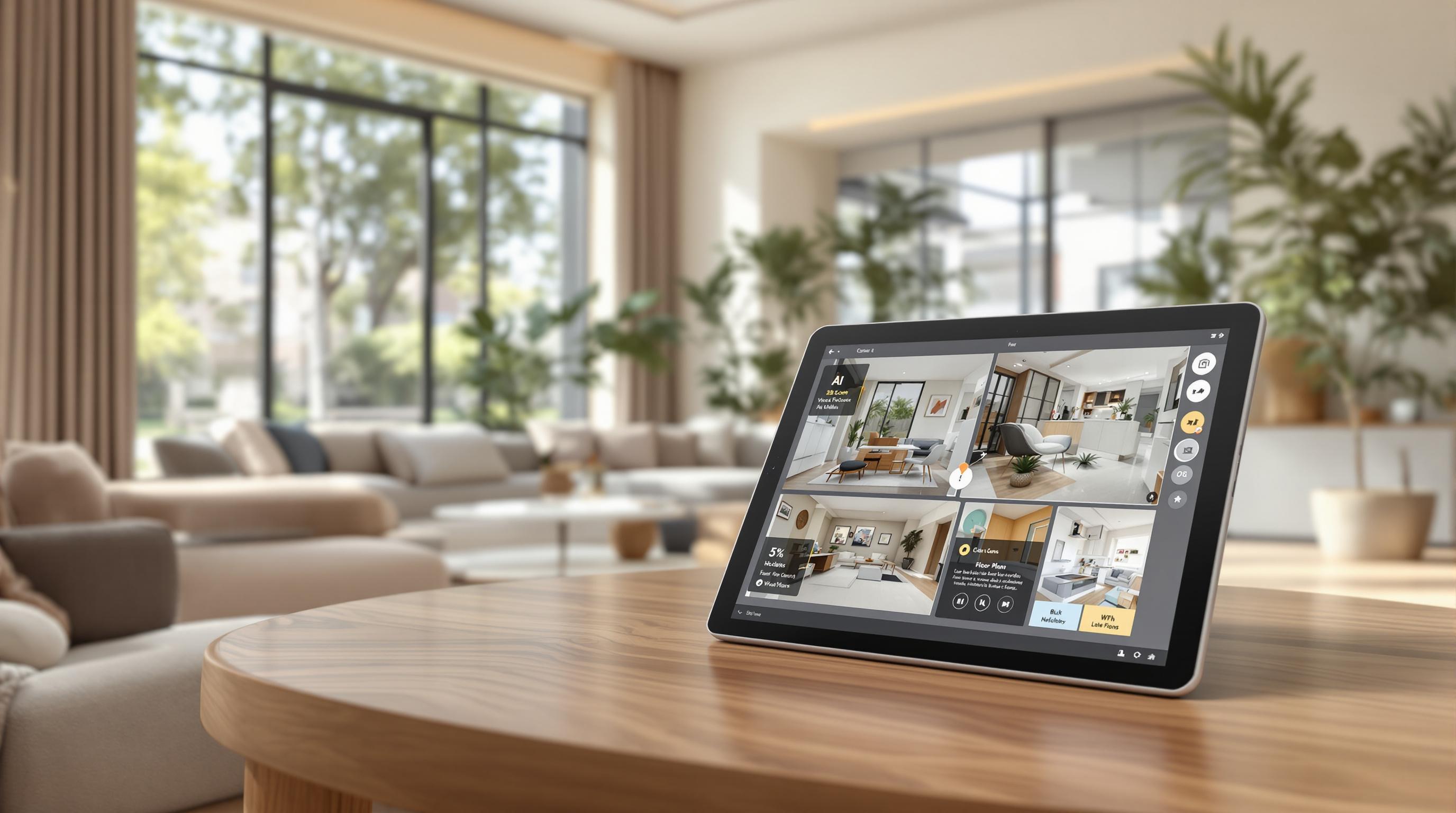CMA tools help real estate agents quickly and accurately determine property values using data from MLS databases and market trends. These tools simplify the process by:
- Collecting Data: Pulling property details, recent sales, and market trends.
- Finding Comparables: Identifying similar properties based on size, location, and features.
- Adjusting Values: Accounting for differences like upgrades or market changes.
- Generating Reports: Creating professional, data-backed valuation reports.
For better results, combine CMA tools with local market knowledge and verify data accuracy. Use AI tools to enhance analysis, automate tasks, and stay updated with market shifts. This approach ensures precise valuations and builds trust with clients.
How To Do A Comparative Market Analysis For Real Estate ...
Core Features of CMA Tools
Modern CMA tools use advanced technology to turn raw property data into useful valuation insights. One standout feature is the MLS Data Connection.
MLS Data Connection
Having a direct link to MLS databases is crucial for accurate property valuations. This connection delivers real-time updates on listings, price adjustments, and recent sales, ensuring assessments are always based on the most up-to-date and trustworthy information.
How to Value Properties with CMA Tools
Here’s a straightforward process to evaluate properties using Comparative Market Analysis (CMA) tools:
Enter Property Information
Start by entering all the essential details about the property, such as:
- Basic details: Square footage, number of bedrooms and bathrooms, lot size, any upgrades, special materials, and amenities. Include photos for a complete picture.
- Location details: The exact address, neighborhood characteristics, and school district information.
- Current condition: Note maintenance status, any required repairs, and recent renovations.
- Unique features: Include standout elements like scenic views, waterfront access, or historical importance.
Choose Comparable Properties
Next, identify similar properties, known as comparables, that align with these criteria:
- Located nearby.
- Sold within the last 3–6 months.
- Similar size (within 20% of the subject property’s size).
- Same property type and style.
- Comparable lot sizes and features.
Prioritize sold properties over active listings. Sold listings provide a more accurate reflection of market value.
Make Property Comparisons
Adjust values based on differences between the subject property and the comparables. Focus on:
- Location: Account for neighborhood features or desirability.
- Size: Compare price per square foot.
- Features: Consider amenities or upgrades.
- Condition: Factor in renovation needs or recent updates.
- Market timing: Adjust for any major market changes since the comparables sold.
These adjustments help create a precise, data-backed valuation.
Create and Review Reports
Finally, generate professional CMA reports that include:
- Photos and detailed descriptions of the property.
- A clear comparison with selected comparables.
- Adjustments made for differences.
- Relevant market trends.
- A final value range based on the analysis.
When presenting the report, explain the adjustments and findings clearly to build trust and confidence with your clients.
sbb-itb-db182b0
Tips for Better Property Valuations
Verify Data Accuracy
The reliability of property valuations starts with accurate data. When using CMA tools, make sure to check these critical aspects:
- MLS Data Updates: Confirm that your CMA tool uses the latest MLS data for precise information.
- Property Details: Double-check details like square footage, room counts, and lot size against trusted records.
- Comparable Sales: Rely on recent sales data to ensure comparisons align with the current market. Pay extra attention to automated calculations, especially for unique features or recent renovations.
Combine Tools with Local Expertise
CMA tools are helpful, but pairing them with local knowledge results in better valuations:
- Neighborhood Trends: Take into account local factors and trends that automated tools might miss.
- Market Conditions: Include seasonal shifts and local market dynamics that influence property values.
- Property Inspections: Adjust valuations based on in-person assessments rather than relying only on reported details.
- Buyer Preferences: Factor in features that are particularly appealing to buyers in your area.
Keep Valuations Updated
The real estate market changes quickly, so staying current is essential:
- Regular Updates: Review comparable properties periodically to spot market changes.
- New Data Alerts: Update valuations when new comparable sales or market shifts occur.
- CMA Tool Monitoring: Use your CMA tool’s alerts to track properties needing revaluation automatically.
Solving Common CMA Tool Problems
Working with Few Comparables
When you're dealing with a limited number of similar properties, it's important to expand your search thoughtfully while staying accurate. Here’s how:
- Look beyond your immediate area but stick to relevant market zones.
- Review a broader range of recent sales data.
- Include properties with similar key features, even if their architectural styles differ.
Make adjustments for variations in size, lot dimensions, age, and location, keeping current market conditions in mind. These steps can help you manage the challenges of limited comparables while maintaining reliable results.
Managing Market Changes
Valuations can shift quickly with market conditions, so staying updated is crucial. Regularly:
- Keep an eye on active listings and pending sales to identify trends.
- Track metrics like days on market and the ratio of listing price to sale price.
- During unpredictable periods, focus on the most recent comparable sales, document any market adjustments, and note local factors that could influence property values.
Staying proactive with these updates ensures your valuations remain accurate and relevant.
Presenting Results to Clients
Clear communication is key when sharing your findings with clients. Make sure your presentation builds trust and understanding by:
- Using charts and graphs to visually represent price trends and comparisons.
- Highlighting the main factors influencing the valuation.
- Sharing neighborhood insights and current market trends.
- Explaining how specific property features impact the value.
Start your discussion with the strongest comparables, explain significant adjustments, and provide context for any unique property characteristics. Address potential concerns upfront to instill confidence in your analysis and the capabilities of your CMA tools. This approach reinforces your expertise and ensures your clients feel informed and reassured.
Adding AI Tools to CMA Work
Incorporating AI tools into your CMA workflow can improve both precision and efficiency. These tools work alongside traditional CMA software to provide better market insights and simplify data analysis.
Property Descriptions Made Easier
AI-powered platforms can create polished property listings that highlight key features. Tools like Real Estate Descriptions AI ($24/month) and Write.homes ($8-$80/month) produce detailed descriptions emphasizing features that affect CMA calculations. This ensures your property documentation is consistent and professional.
Automating Market Analysis
Tools like LocaleScan offer neighborhood insights that enhance CMA calculations by covering:
- Local market trends
- Property value changes
- Demographic updates
- Effects of new developments
These insights provide a more precise understanding of the market.
Efficient Data Processing
AI platforms can quickly extract and process property details from multiple sources, ensuring accuracy throughout your CMA workflow.
AI for Visual Property Assessments
Visualization tools powered by AI can add depth to property valuations. Here’s a quick breakdown:
| Tool | Function | Price | Benefit for CMA |
|---|---|---|---|
| VirtualStagingAI | Digital staging | $5/image | Highlights property potential |
| AI Home Design | Photo enhancement | $0.24/photo | Enhances comparable property data |
| RealtyGenius | Market visualization | $17-$507/month | Improves data presentation |
These tools help present properties in their best light and make comparisons more effective.
CRM Integration for Better Organization
Platforms like Outpost CRM ($29/month for solo agents) help manage property data and track market trends. Its AI features can identify patterns in property values and shifts in the market, keeping your CMAs current and relevant. This ensures a streamlined, data-driven approach to property valuation.
Best Practices for AI in CMA Workflows
To get the most out of AI tools, keep these tips in mind:
- Focus on tools that directly enhance your CMA process.
- Use AI-generated insights to support - not replace - your expertise.
- Update your tools regularly to access the latest market data.
- Cross-check AI findings with traditional CMA metrics for accuracy.
For a curated list of AI solutions tailored to real estate professionals, check out AI Tools For Real Estate Agents. These tools range from basic automation to advanced market analysis, helping you refine your CMA process.
Conclusion: Making the Most of CMA Tools
CMA tools play a key role in delivering accurate property valuations in today’s fast-paced real estate market. By combining traditional features with advanced AI-driven capabilities, agents can offer precise, data-backed valuations that help earn client trust.
The key to success lies in pairing the analytical power of CMA tools with your local market expertise. This ensures valuations are accurate and practical, as discussed in our section on incorporating AI tools.
Here are some key practices to guide your approach:
- Check your data: Consistently verify the quality of your data throughout the valuation process.
- Keep comparables up-to-date: Regularly refresh your property data to reflect the latest market conditions.
- Provide clear reports: Ensure clients understand the methods behind your valuations.
- Use AI wisely: Leverage AI to enhance your analysis while applying your professional judgment.


